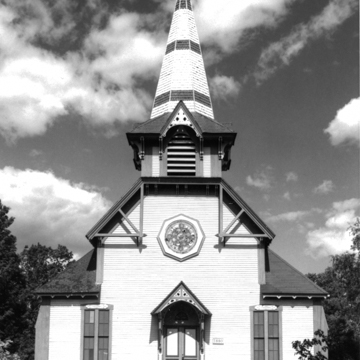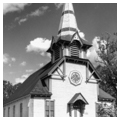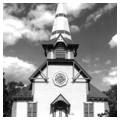Rural Vermont is blessed with a collection of small but noteworthy vernacular country churches built in the nineteenth century in styles that demonstrate community pride. Prime examples can be found among the multiple Presbyterian churches of Scottish-settled Ryegate. This Stick Style church is a Vermont rarity. Essentially a simple rectangular block, it has a steeply pitched roof and a gable front cut with hipped corners to create the effect of a central, tower-bearing gambrel pavilion. The wooden corner buttresses, over-sized right-angle pseudo-framing beneath the slopes of the gambrel, and octagonal spire splaying to form a bracket-supported and gabled belfry hood may suggest awareness of similar motifs on the contemporary St. Andrew's Episcopal Church in nearby St. Johnsbury (CA15). However, exposed rafter tails, elaborate brackets, Eastlake-inspired lintel boards, and pierced gable screens over the door and on the belfry give this symmetrical facade its own vigorously decorative character.
Another fine Presbyterian church is the richly textured and polychrome frame Victorian Gothic United Presbyterian Church (1890) on Bayley-Hazen Road in Ryegate Corner, a structure its builders declared to be one of the finest village churches in the state.





